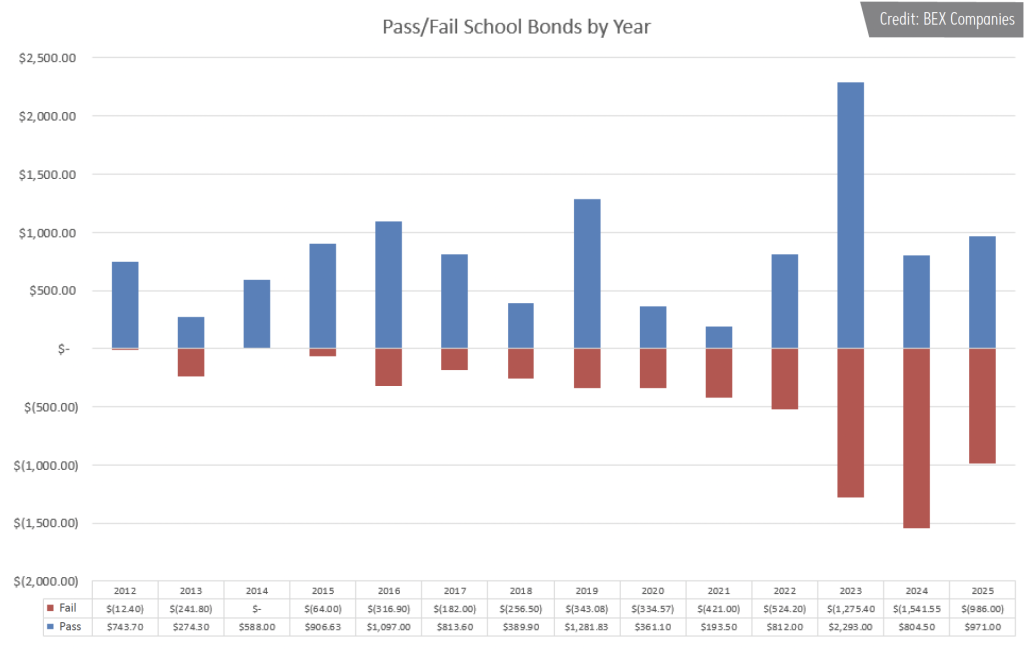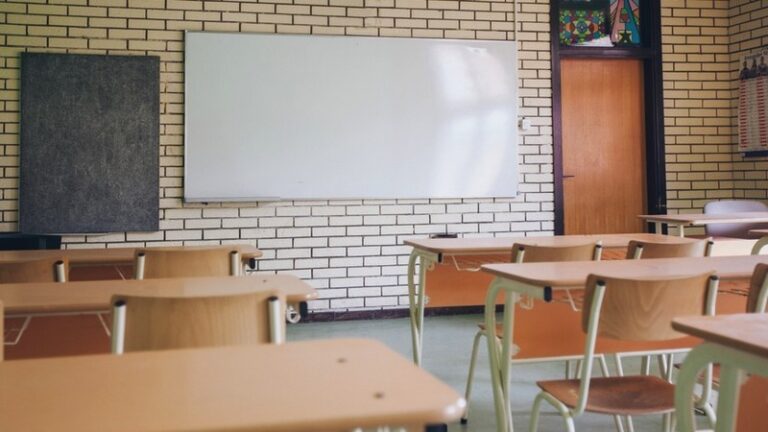By Rebekah Morris for AZBEX
Across Arizona, voters were asked to support local school districts with their facilities needs via bond questions at the ballot. The results were split.
Bonds for school districts work like mortgages – the district takes on debt backed by property tax revenue paid by the voters. BEX started tracking K12 bond measures in 2012 and has noticed a significant decline in bond approval rates since 2020. From 2012 to 2020, voters typically approved 80% of K12 bonds. Since 2020, however, that approval rate has dropped to roughly 50%.
This year, 16 questions totaling $1.957B were on the ballot for K12 bonds. Of the total, $971M, or 49.62%, was approved, while $986M, or 50.38%, was voted down.

Bond funds are restricted to capital expenditures: physical assets that have a depreciable lifespan. Allowable expenditures include land purchases, building and facility upgrades, deferred maintenance, new facilities, security upgrades, and even buses, textbooks and technology. While not all bond funds are directed toward construction and building projects, the biggest K12 projects we see in the market are most often funded with bonds.
Below are tables by county of relevant districts and their respective bond amounts:

Of the bond questions that passed, below are highlights of planned projects.
West-MEC – $415M: Bond question successfully passed by voters. From the voter pamphlet, West-MEC intends to fund:
• Construction of new campuses to accommodate program expansion in high-demand fields, such as healthcare, welding, technology and other skilled trades – $151M;
• Upgrades to current facilities, including safety, security and technology – $25M;
• Expansion of programs at existing campuses – $215M, and
• Improvements to administrative infrastructure, including safety and security – $23.4M.
Chandler Unified School District – $271.5M: Voters in Chandler declined to support a much larger bond ($475M) in 2024. After revising down the list of requested projects, the District was successful at passing a smaller (although still significant by all counts) bond in 2025. From the voter pamphlet, planned expenditures include:
• Purchase of pupil transportation vehicles – $4M;
• Purchase furniture, equipment and technology for instructional purposes – $80.8M, and
• Maintenance, improvements and renovations to school facilities, including security enhancements, acquisition of land and new construction – $186.7M.
Tempe Elementary School District – $196.5M: This is the second bond ask of voters for the same amount, the last one being in 2022. That measure passed as well. From the voter pamphlet, planned expenditures include investments at Fees College Preparatory Middle School, Rover Elementary, and Carminati Elementary School. In addition, the bonds will be used to install solar panels and other energy efficiency projects throughout the District.
• $M school renovations, including safety improvements, critical maintenance projects, furniture, equipment and technology – $186M, and
• Critical maintenance projects for district support facilities including furniture, equipment and technology – $10.5M.
Sunnyside Unified School District – $120M – Prop 416: Voters have not been asked to support a bond for this district since at least 2012. Per the voter pamphlet, planned expenditures include:
• Construction, renovation and modernization of all 21 school sites and grounds, including Sunnyside High School building replacements – $58M;
• Critical safety and security improvements – $10M;
• Athletic and Fine Arts facility upgrades – $5M;
• Replacement and upgrades of structural, mechanical, plumbing, electrical, roofing systems – $43M;
• Classroom technology, furniture and equipment – $2M, and
• Student transportation vehicles – $2M.
Failed Bond Questions Often Repeat
Some of the districts where voters did not support the bond question(s) are not newcomers to the disappointment of a bond failure.
Despite rapid population and employment growth across the city, Buckeye Union has requested bond support six times since 2012 and has mustered voter approval for a $49M bond once, in 2014. Similarly, Dysart Unified School District, covering the West Valley areas touching Luke AFB, El Mirage, Surprise, and some parts of Sun City, has similarly experienced a consistent lack of voter support. Voters in this area have denied the district bond approval four times since 2013.
State Support Lacking, Districts Turn to Bonds
Arizona has a long history of underfunding capital needs for public K12 school districts. Twice in our history, class action lawsuits have been filed against the State by local districts, and twice the evidence resoundingly pointed to the State not funding the schools’ needs as constitutionally mandated. The most recent verdict was handed down in August 2025. It will be a long and slow process to see funding materialize as a result of that verdict.
In the meantime, public K12 districts continue to rely on the good graces and willingness of voters to approve bond questions to fund needed capital projects.

